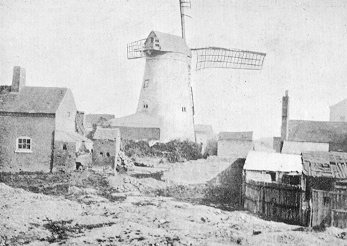Old Wells and a Windmill Wolverhampton Old Wells It is difficult to obtain reliable information regarding the old wells of Wolverhampton. Some 150 years ago a well existed in Chapel Ash, called the Spa well, and was said to possess remarkable healing properties; and the well in Chapel Yard, off North Street, the water from which is still used for drinking purposes, was credited with possessing properties for alleviating all eye afflictions; whilst the water from the "Crib" pump, which formerly stood where now stands the Church Institute, in St. Peter's Square, was sought for on account of its medicinal qualities. Dr. Plott states that Wolverhampton had but four weak springs to supply the town, rising together behind the Cock Inn, in Berry Street, having different names appropriated to their several uses; the Pudding Well, the Horse Well, the Washing Well, and the Meat Well, from which last was fetched the water used for meat or drink all over the town in great leather budgets, laid across a horse, with a funnel at the top to fill them. Dr. Plott states that, notwithstanding the scarcity of water, and the adjacent coal mines, the people of Wolverhampton enjoyed a more settled health than most of their neighbours, "on account of their breathing a more subtle and refined air" which statement is in direct contradiction to that made by the imaginative London writer.
There was one opposite the Woolpack, on Snowhill; another in Bilston Street, near Nock and Joseland's; one in Canal Street, near the Harp Inn; one near the Four Ashes Inn (then the Old Horse Blockhouse.), top of Charles Street; one opposite Cope's Liquor Vaults, Queen Square, and another near top of Tup Street (near North Street); in North Street there was one opposite where Walter's Lock Works are now, another lower down near Malthouse, and a third on the broad pavement in North Street, what remains of which being shown in our illustration. In addition there were a great number of private pumps. In Charles Street there was a soft-water pump for which one halfpenny was charged per bucketful. It would be interesting to know whether our authorities have located the places where all these wells existed. After what occurred at Hanley, the public should have an assurance that their lives are being safe guarded. It is only a few years back that the landlord of the Pack Horse, Dudley Street, had a miraculous escape from death through the top of an old disused and unknown well giving way in his back premises, and only a fortnight ago a man working at the back of a shop in the Parade, Birmingham, found his foot sinking into the ground. Fortunately, he stepped out of the way, and it was found that one of the bricks with which the yard was paved had disappeared. Upon investigation, it was found that the place which had given way was the covering of an old pump well. It was 21 feet deep and three feet wide. The covering consisted of pieces of wood, which had rotted with age, and a quantity of soil. Our illustration also shows an old public house, called "The Plume of Feathers." It is said to be the oldest full-licensed house in Wolverhampton, dating back 400 years. It is a curiously constructed house, and the original occupier was evidently not a six-footer, for the ceilings are very low, especially upstairs. Another peculiarity is, that having to ascend two steps to enter the front way, there are six steps to mount to reach the back yard, whilst there is only one step to descend to get to the cellar. The old public, having for its close companion the tumble down old pump, forms a striking picture of old Wolverhampton.
The Old Windmill, Stafford Street The site of this bit of old Wolverhampton is now occupied by the Windmill Steam Joinery Company. It had rather an inglorious end; simply tumbling down on Christmas Eve, about ten years ago. It has no history of interest, and at the time of the collapse it had long ceased to be of any service beyond being used as a store house. Its foundations had been undermined in the digging for sand, and the men with their horses and carts had only left about a couple of hours before the building fell, or the loss of life would have been serious. As it was, no one was injured. A football match was in progress at Molineux Grounds at the time, and the crash was distinctly heard by the spectators, causing some little consternation and much wonderment as to what the noise meant. The fall of the old mill created the usual nine days' gossip in the neighbourhood, and was then forgotten. In connection with the mill, there is a story told of an old woman and her donkey.
History. does not relate how the donkey was released. |





